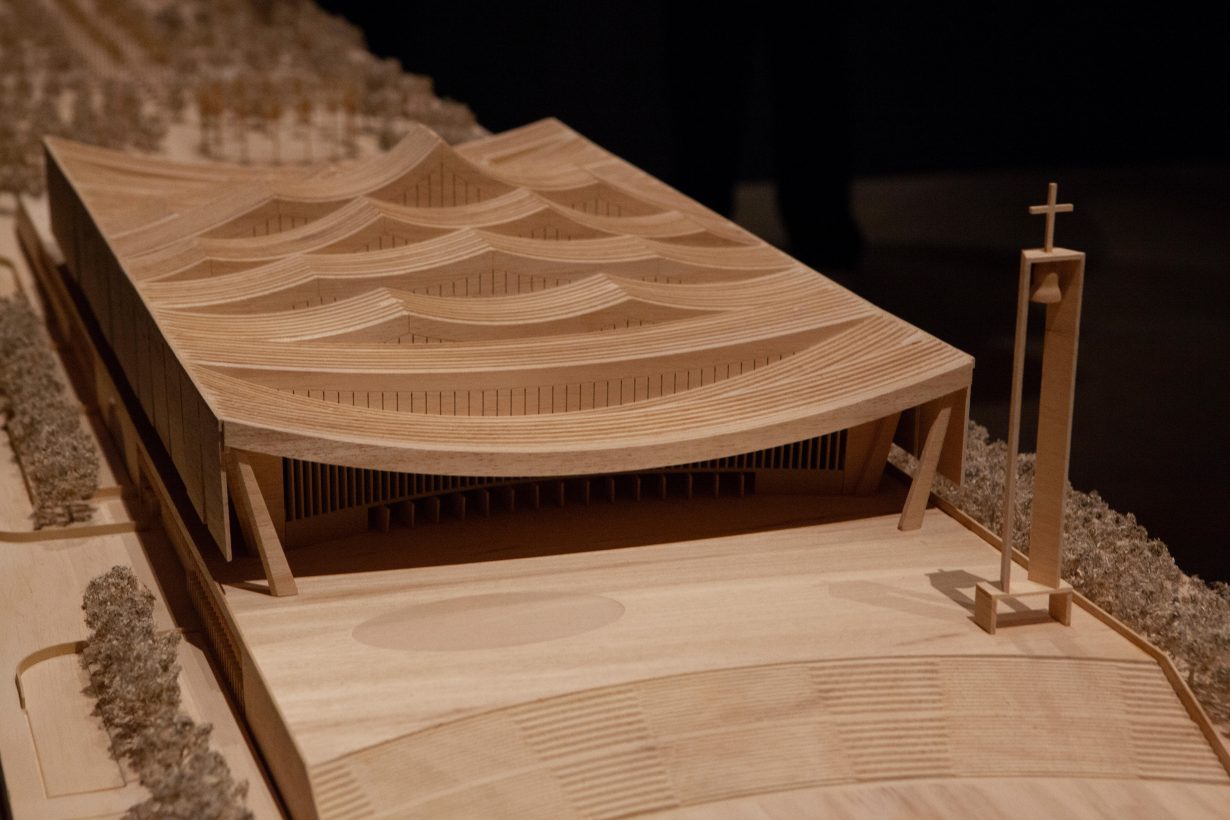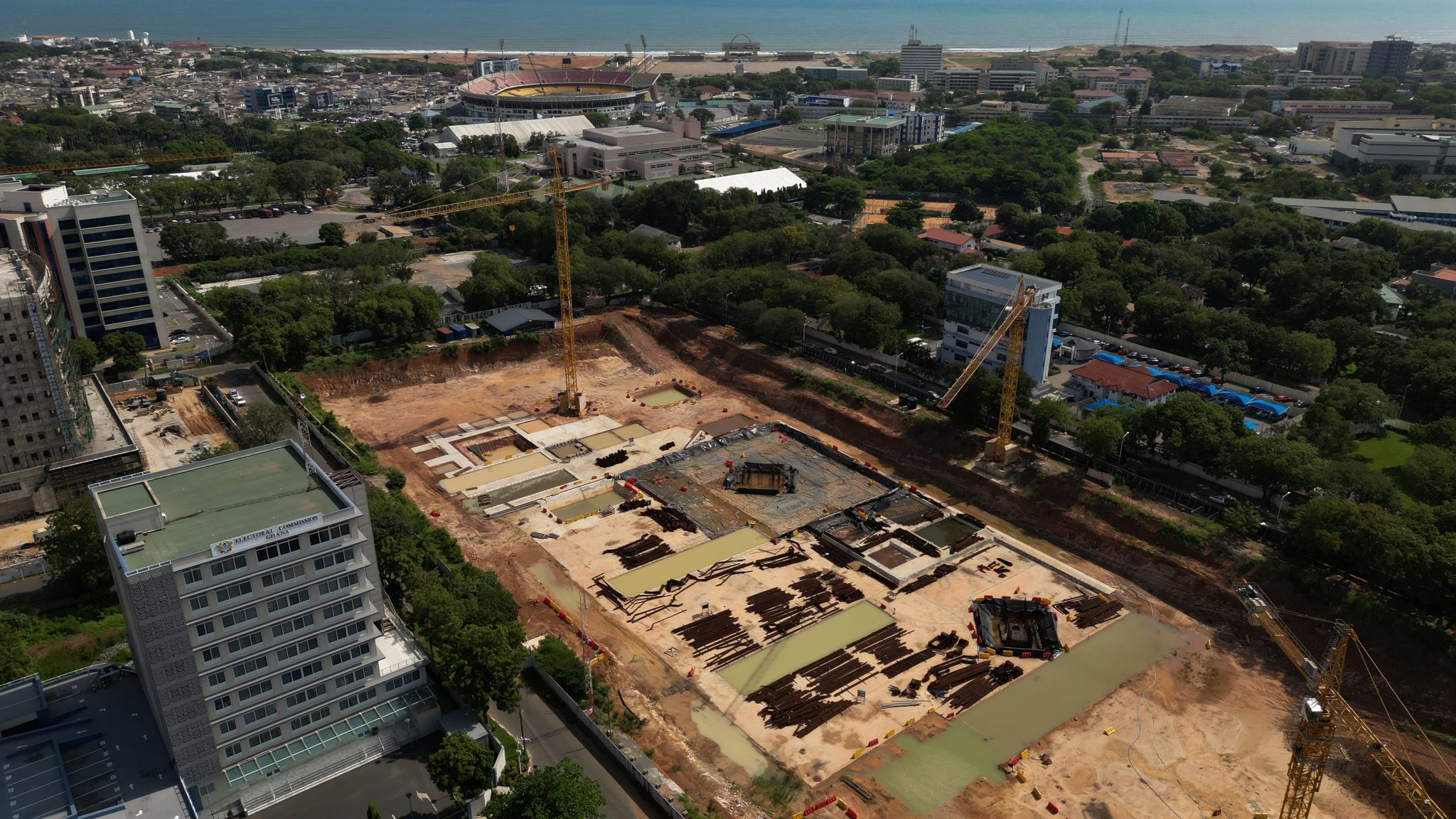What is the real scandal surrounding Adjaye’s work in Ghana, asks Anakwa Dwamena, as he explores its afterlives in Accra
The skyline of downtown Accra is studded with eccentric buildings, and each tells a piece of Ghana’s complicated history. The National Theatre, opened in 1992, with its Ark-like top-structure pinned to a rectangular base, is testament to an era when culture was an arena for national identity-making and architecture was the equivalent of placing meringues on pies. Much more modest, the squat, two-storey George Padmore Research Library on African Affairs from 1961 nods to Ghana’s status as a resource centre for liberation movements across the continent. And to independent-Ghana first president Kwame Nkrumah’s fever dream of a United States of Africa (cooked up by Nkrumah with Padmore at the Fifth Pan-African Conference in 1945).
On that same stretch is a seven-hectare empty lot, known locally as ‘the world’s most expensive hole’. Here, historic colonial-era bungalows for top judges were knocked down for a proposed National Cathedral. First announced in 2016, the project was to be a fulfilment of the president’s personal pledge to God – though the government dipped into taxpayer money to fund it, without parliamentary consent. The final design, intended to be completed this year, was to have ‘chapels, a baptistery, a 5000-seat, two-storey auditorium, a grand central hall, music school, choir rehearsal room, art gallery, shop and multi-use spaces’.
Adjaye Associates, whose project this is, have been paid about half of the £45.5 million spent, but with nothing (save some foundation work) yet built, as far as the eye can see. Down towards the beach is another Adjaye white elephant: the redevelopment of close to 100 hectares of coastline, featuring skyscrapers, parks and promenades intended to woo tourist dollars. Now apparently stalled, Marine Drive has already led to the eviction of thousands of people, has made one of the few beaches accessible for low-income residents unreachable, and if it goes ahead promises to destroy two sites of cultural heritage: the Art Centre Accra, where Ghana’s distinct Concert Party Theatre troupes were nurtured, and the Ghana Club, a haven for Ghanaian elites during the 1940s and 50s, when parts of Accra were segregated by race.
This has, for many, made David Adjaye the face of destruction. Adjaye’s public projects haven’t measured up to his own assertion to Artforum in 2017 that projects must ‘engage with the city and its context’. His completed buildings in and around Accra to date are private projects: including a house for former UN Secretary-General Kofi Annan; the Sandbox Complex, a beachside playground for the upper class; and the dot. ateliers studio for the artist Amoako Boafo.
The context of Accra is one of rising inequality and an increasingly callous elite, obsessed with accumulating Western markers of sophistication – V8 cars, vacations in the Mediterranean and gaudy homes that have conspired to make Accra among the most expensive cities on the continent. Against this, the opening of Adjaye’s studio in Accra in 2017 set off a distinct air of Ghanaian, African and Black pride in a moment when the country was busy cultivating its global image as a home for celebrating a Pan-African vision of excellence. Adjaye had been known for calling architecture a ‘Robin Hood practice’, and a means to give the poor, through public works, the glossy things the rich already have. His work, the Yoruba-inspired National Museum of African American History and Culture in Washington, DC, being among the most prominent examples, is deeply steeped in African aesthetics. The prospect of his design for the W.E.B. Du Bois Museum Foundation Complex in Accra was an exciting notion; yet it remains another project in limbo.

To be sure, Ghana was no architectural backwater before Adjaye. (A current show at London’s Victoria and Albert Museum highlights the country’s role in the development of ‘tropical modernism’ during the 1960s.) But perhaps, besides the sculptor El Anatsui, there are no similarly ‘big fish’ in our pond, at least not any with the kind of external recognition that Adjaye has to back him up: a knighthood, an OBE and Obama’s endorsement.
So, a rare announcement from Adjaye Associates this March served as a reminder of the bitter disappointment of Adjaye’s time in Ghana: the release announced a ‘fundamental change’ to the way the firm operated, pointing to the appointment of a new CEO for its Accra studio (as well as similar appointments in its London and New York outposts), and David Adjaye’s continued place as principal and head of design direction in the role of executive chair of the group.
In Ghana this announcement represented the closest thing to an update, or new information, since the Financial Times revealed (in 2023) sexual-misconduct allegations against Adjaye. (Through a communications and crisis management firm, Adjaye has rejected ‘any claims of sexual misconduct, abuse or criminal wrong-doing’.) Elements of the Ghanaian press framed the accusations as ex-employees seeking to ‘extort money from Adjaye’. In other countries, he was compelled to step back from large projects in which he and his firm had been involved, as soon as the allegations became public.
Here, there seems to only be silence, and a collective shrug. After a University of Ghana lecturer, Ransford Gyampo, was caught on tape in 2019 making inappropriate advances to a reporter posing as a student, he was slapped with a six-month suspension, and returned to even more prominence as a frequent guest on national television. Adjaye could follow this reentry into public life, just like fellow architect Richard Meier, following five published allegations of sexual abuse (and one reported settlement).
Back in Ghana, the presence of a starchitect seems only to have amplified preexisting negative traits in the society in general, and in architecture specifically: proximity to power leads to one becoming untouchable, even in the face of loud opposition. Darlings of the president, Adjaye and his firm were handed big projects without parliamentary approval. In one case, a project was alleged to have been taken from an architect who already had a contract and given to Adjaye. This led to consortia of architects petitioning various authorities about the lack of open and competitive bidding processes around Adjaye Associates.
The firm’s website still tags the National Cathedral, the Du Bois Museum Complex and others as ‘current’ projects, in contrast to on-the-ground reality. In the midst of a lack of transparency, and accountability, what remains clear is the mistake we make when we expect global celebrities who have cut their teeth in the transactional corridors of the corporate world to switch to an opposite ethic in the name of local solidarity or values. ‘Architecture’, Adjaye once said, ‘can very much be a tool to bridge historical gaps between people, one that can offer disadvantaged communities a source of pride and inspiration.’ Unfortunately, this has not been the case in Ghana.
Anakwa Dwamena is a writer based in Accra
